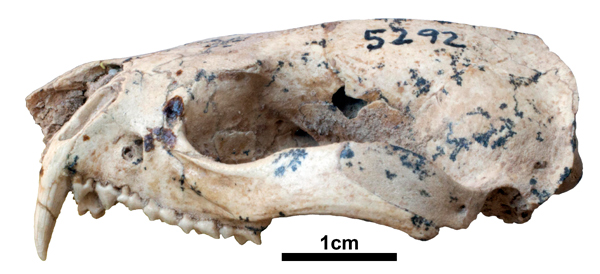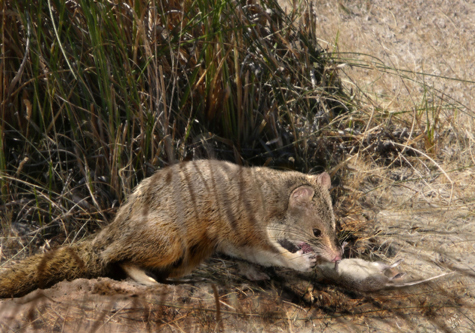Cute and Cuddly Marsupial Had a Fearsome Fossil Relative
Sparassocynus – A Pliocene Predator
Scientists, including a researcher from the University of Salford (Manchester), writing in the academic publication the “Journal of Mammalian Evolution”, have shed further light on a predatory prehistoric marsupial from the Pliocene of South America. Sparassocynus might be related to living short-tailed opossums, but unlike its extant relatives, Sparassocynus was not insectivorous, most likely, other small mammals were on the menu.
A Life Reconstruction of Sparassocynus
Picture credit: Velizar Simeonovski
Sparassocynus derivatus
Living short-tailed opossums are cute and most are not much bigger than a squirrel, but these natives of South America had a bigger and ferocious fossil relative. The joint British and Argentinian research team have shown that Sparassocynus, is an extinct carnivorous relative of today’s cute and cuddly short-tailed opossums. The Sparassocynus genus has been known to science for over a hundred years, but its evolutionary position within the Didelphimorphia, that great clade of marsupials that includes the specious opossums and their relatives has been uncertain. However, Dr Robin Beck, a mammal systematist at the University of Salford, in collaboration with Matías Taglioretti (Museo Municipal de Ciencias Naturales “Lorenzo Scaglia”, Argentina), have clarified its taxonomic position.
The pair of scientists focused their attention on a 4-million-year-old skull of Sparassocynus (Sparassocynus derivatus), that provided vital new information about this genus. The skull was found in 2012 by Taglioretti and colleagues in a fossil deposit in cliffs along the Atlantic coast of Argentina, near the city of Mar del Plata (Playa Las Palomas).
Commenting on the significance of the skull fossil find Dr Beck stated:
“As soon as Matías showed me the skull, I knew it was really important. It’s almost perfectly preserved, and it’s not fully grown [it still has its baby teeth], so it preserves a lot of features that are not visible in other specimens.”
The Juvenile Sparassocynus Skull Fossil (Lateral View)

Picture credit: Dr Robin Beck (University of Salford)
Comparing Anatomical Characteristics
By comparing over a hundred different anatomical characteristics, and incorporating DNA evidence from living species, Beck and Taglioretti showed that Sparassocynus is an extinct member of the opossum family and is most closely related to the much more cute and cuddly, insect-eating short-tailed opossums.
Dr Beck added:
“This might seem surprising because Sparassocynus was clearly a carnivore that would probably have eaten rodents and other small vertebrates, whereas short-tailed opossums are about five times smaller and mainly eat insects, but they share some unusual features that indicate a close relationship.”
The “Great American Biotic Interchange”
Sparassocynus survived in South America until about 2.5 million years ago, when it may have been driven extinct by the arrival of weasels from North America in what is known as the “Great American Biotic Interchange”, the land masses of North America and South America were finally united when the Panama land bridge became complete. There are over a hundred species of opossum still alive today in South America, of which, twenty-four are short-tailed opossums. Thankfully, none of these extant species are quite as ferocious as Sparassocynus would have been.
The scientific paper:
“A nearly complete juvenile skull of the marsupial Sparassocynus derivatus from the Pliocene of Argentina, the affinities of “sparassocynids” and the diversification of opossums (Marsupialia; Didelphimorphia; Didelphidae)” by RMD Beck and ML Taglioretti published in the Journal of Mammalian Evolution.
Everything Dinosaur acknowledges the assistance of a press release from the University of Salford in the compilation of this article.
Visit Everything Dinosaur: The Everything Dinosaur Website.


